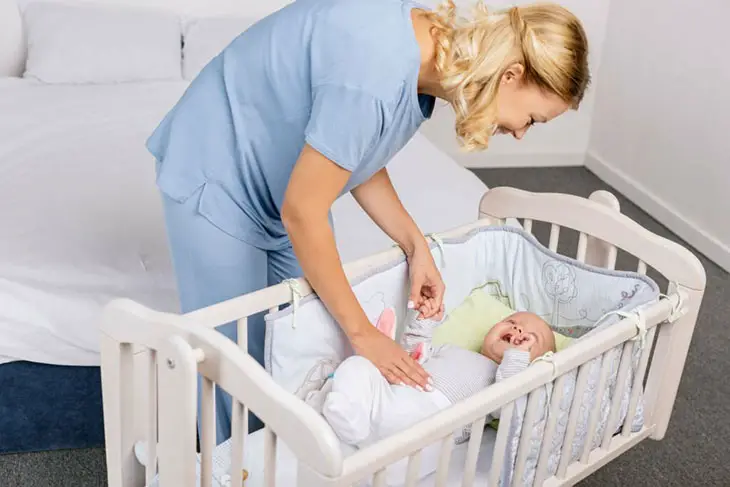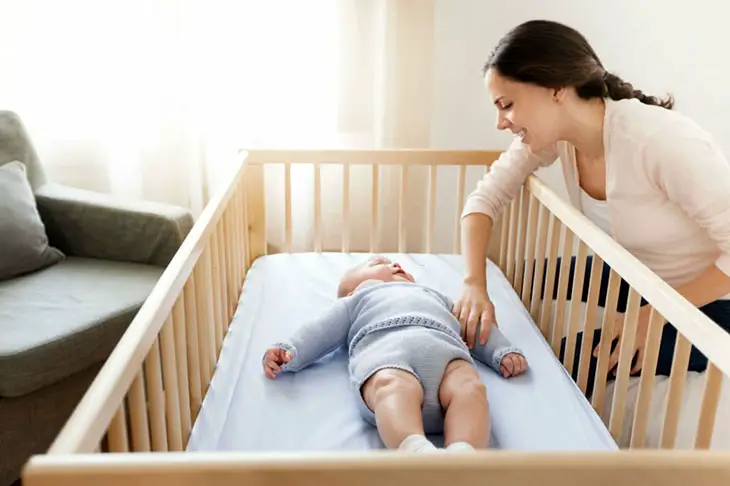Will i break my babys crib if i get in? Well, the thought of getting into your baby’s crib might have crossed your mind, but is it a safe idea?
Here, I will tackle this question from multiple angles in this informative discussion.
Please continue reading to the end to receive some alternatives yet a safe way to do it. Let’s delve deeper into this topic.
Will I Break My Babys Crib If I Get In?

Mostly no. However, it is recommended not to do so because the crib is not designed for adults.
The normal weight capacity of cribs is meant for babies, not adults, and exceeding this limit could lead to structural damage or even complete collapse of the crib.
Here are other angles that you should take a look at!
Crib Size
Can I sleep in my baby’s crib? It is not ideal because of the crib size.
Most cribs come in different sizes, such as mini cribs, standard-sized cribs, and full-size beds. These size variations exist to accommodate the varying needs of growing children.
However, please remember that cribs are primarily designed for infants and toddlers, not for adults. They are not built to withstand the weight and movements of adults.
While snuggling up with your little one in their cozy sleeping space might seem appealing, attempting to fit into a mini crib or even a toddler bed can pose risks to you and the crib.
Trying to squeeze into a mini crib or toddler bed can break the crib, which could lead to accidents and injuries.
Weight Limit
Every crib has a specified weight limit set by the manufacturer, and this limit is there for a reason.
It ensures the safety of your child while they are inside the crib. The weight limit considers the crib’s materials, design, and construction.
Crib manufacturers engineer their products with the safety feature of weight restrictions to prevent accidents and injuries.
Exceeding the weight limit, which is typically designed for an average child, can put immense stress on the crib’s structure.
This stress can weaken components, such as crib slats, crib rails, or even the entire crib itself.
Over time, this stress can cause signs of wear, compromise the crib’s stability, and increase the risk of it breaking.
So, remember that the weight restrictions are in place to protect your child while inside the crib.
Prioritize Your Baby’s Safety
Newborns are incredibly fragile and vulnerable. They have limited neck strength and can’t control their movements well.
Their sleep patterns and bedtime routines are critical for their development, and disruptions can affect their overall health.
Attempting to enter a crib not designed for adult use can lead to unexpected accidents, such as crib rail damage or even crib death due to changes in the crib’s structure.
Therefore, adult use of cribs should be avoided regardless of the type of crib or type of wood used in its construction.
Other Options Instead of Getting into Your Child’s Crib

Crib Beside Your Bed
Can adults get in cribs? Technically, yes, but it’s not a safe practice.
Instead, I recommend placing a crib next to your bed, which is a more practical and secure solution for keeping your baby close.
It allows you to maintain a safe sleep space for your child while providing easy access to nighttime feedings and comfort.
This arrangement is especially beneficial during the early months when babies wake frequently.
Both parent and child can enjoy a good night’s sleep by properly filling the gap between the crib and the bed.
Many parents prefer this setup as it offers the convenience of proximity without the need to get into the crib.
Share, But Be Cautious
Can a crib hold a parent? Maybe. But a shared bed or co-sleeping is a much more ideal option. If you decide to do this, please exercise extreme caution.
Choose a large enough bed to provide a separate sleeping area for your baby, and avoid using a mini crib or standard crib within your bed, as it can pose safety concerns.
The risk of accidental suffocation or entrapment for your baby might happen.
When placed in an adult bed, these cribs may not fit securely or create gaps between the crib and the mattress, which can be dangerous for the infant.
Babies can potentially roll into these gaps, become trapped, or suffocate if their head or body becomes wedged between the crib and the adult mattress.
This is why it’s recommended to avoid placing a crib within an adult bed and instead use separate sleeping arrangements designed with the necessary safety features for co-sleeping or bedside sleeping.
Also, when sharing, ensure the mattress is firm and free of soft bedding, such as pillows or heavy blankets.
Floor Or Air Mattress.
Sleeping on a floor mattress or an air mattress in your child’s room is another option for staying close to your baby without getting into the crib.
The type of arrangement can be particularly useful if your child is transitioning to a new sleep routine or experiencing sleep challenges.
However, remember to maintain a firm surface and ensure no signs of wear on the mattress.
Detailedly, a worn-out mattress can compromise your baby’s safety due to sagging, loss of support, and an uneven surface, potentially causing discomfort and unsafe sleeping positions.
An aging mattress may not meet the recommended safety standards for infants, such as having a firm and flat sleeping surface, which increases the risk of Sudden Infant Death Syndrome (SIDS).
Always keep a watchful eye on your baby in this setup.
Try A Baby Box
Baby boxes are a great alternative to adults getting into baby cribs for several reasons.
These compact, enclosed sleeping spaces are a relatively new but rapidly growing choice for infant sleep.
They offer a snug, secure sleeping environment akin to a traditional crib or bassinet. The benefits of using baby boxes include their convenience and portability.
Hence, they are an excellent option for providing your child with a safe and comfortable place to sleep.
Bassinets
Bassinets are standalone baby sleepers that can be placed next to your bed. They offer a dedicated sleeping space for your baby while still allowing you to keep them close during the night.
They are compact and easy to move. All in all, they can fulfill your desire to be closer to your baby while still ensuring your child’s safety.
But if your baby is too big for a bassinet, consider having a crib beside your bed instead.
FAQs

What Is The Weight Limit For Ikea Crib?
It is around 50-pound. However, the exact weight limit for an Ikea crib depends on the specific model you have.
To find the maximum weight capacity for your crib, check the manufacturer’s guidelines or product manual. Crib weight limits are important to ensure your child’s safety.
Should I Get In The Crib With Baby?
No. For safety reasons, adults are not recommended to get in the crib with a baby.
The crib is designed to provide a safe sleep environment for infants and toddlers, and adding an adult’s weight can exceed the maximum capacity, potentially causing damage or accidents.
Always prioritize your baby’s safety by following the manufacturer’s guidelines.
Conclusion
Will i break my babys crib if i get in? Well, it depends on various factors. You must consider the crib’s design, weight limits, and your baby’s age and development.
I highly recommend seeking advice from pediatricians or baby gear manufacturers, who can offer valuable insights.
Otherwise, go straight to my alternative solutions. Your child’s safety is important, so don’t risk it.
